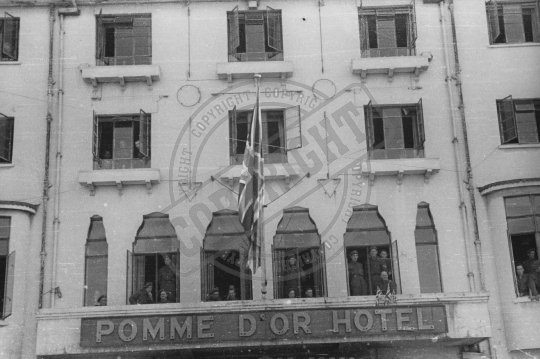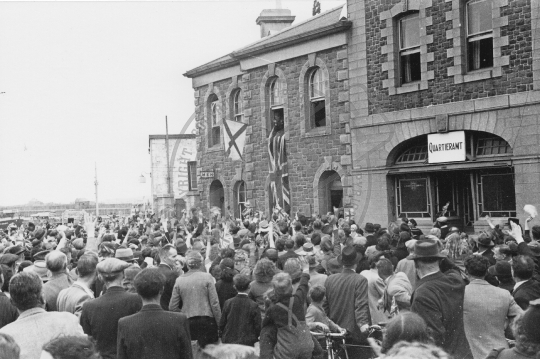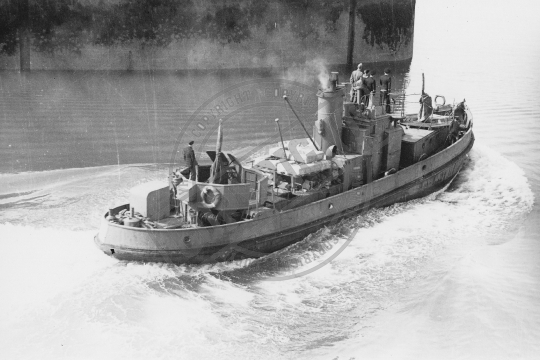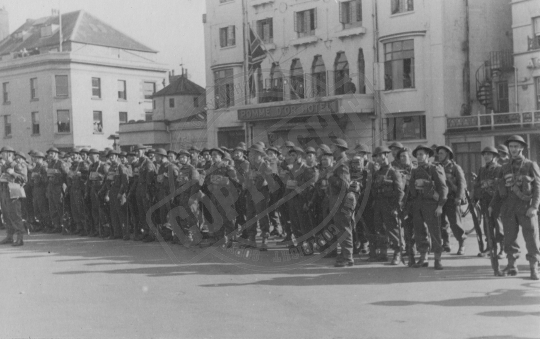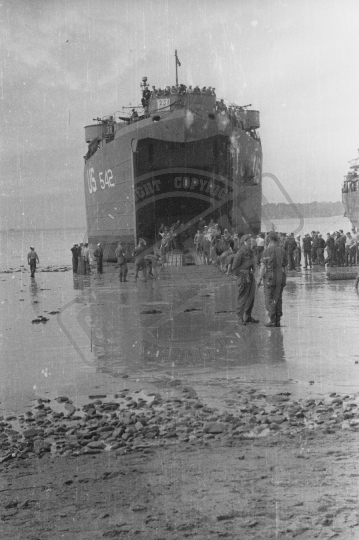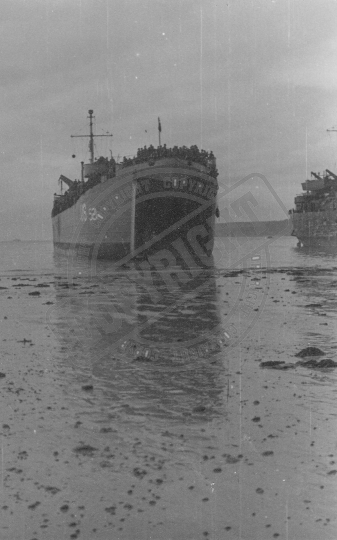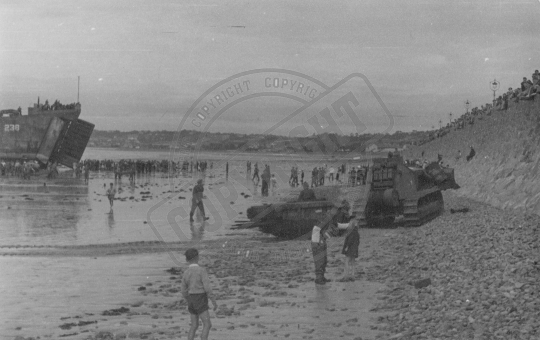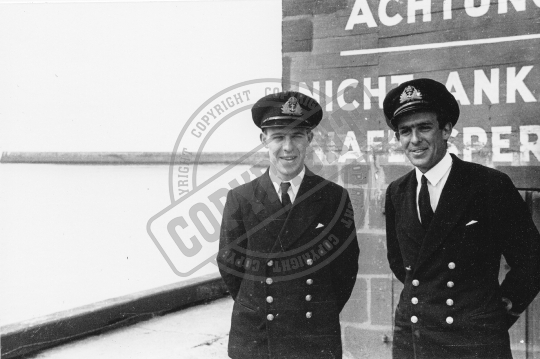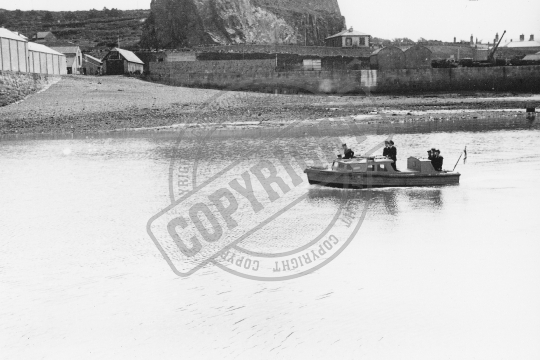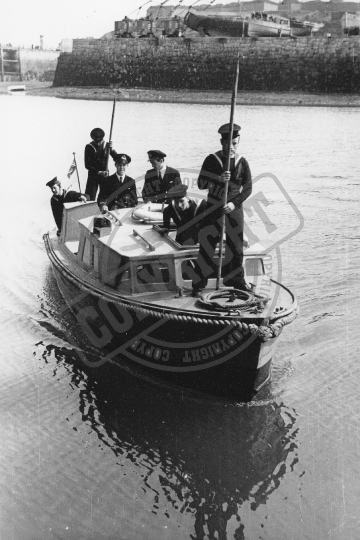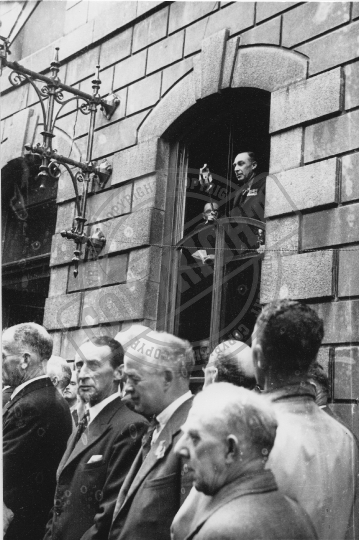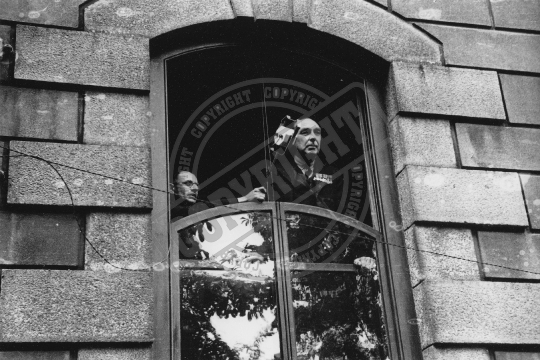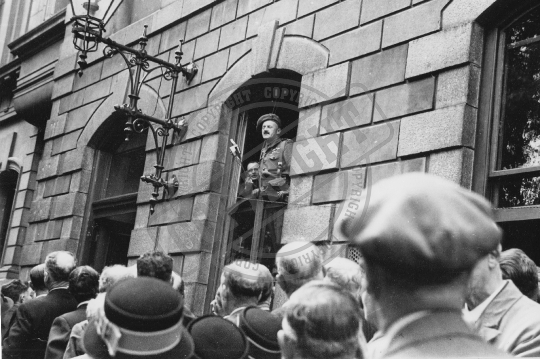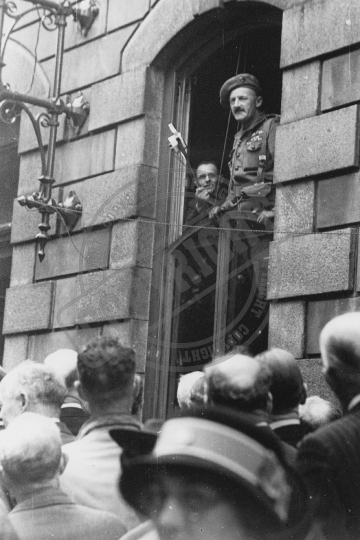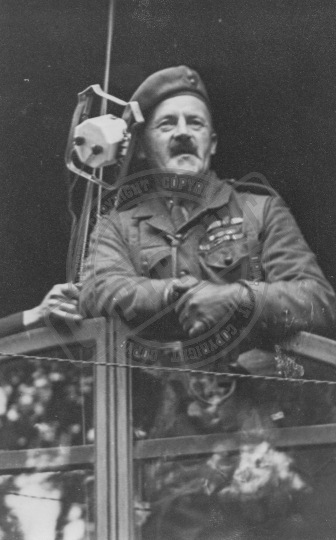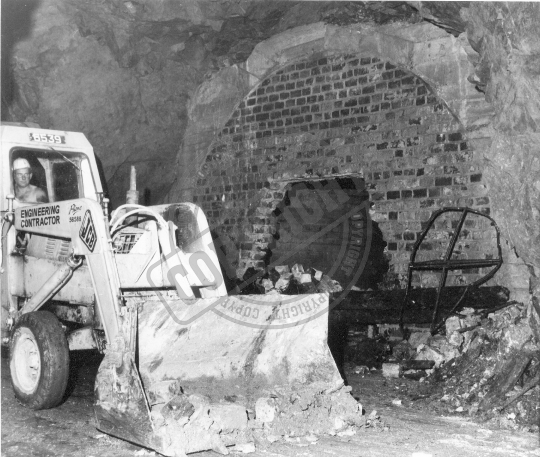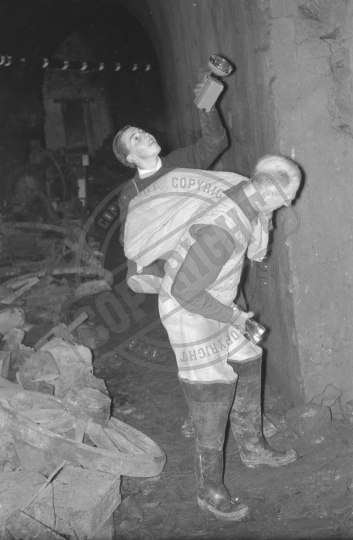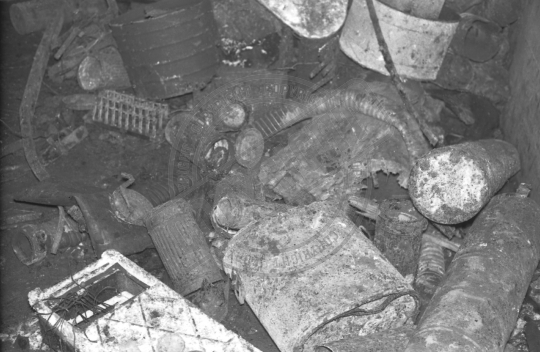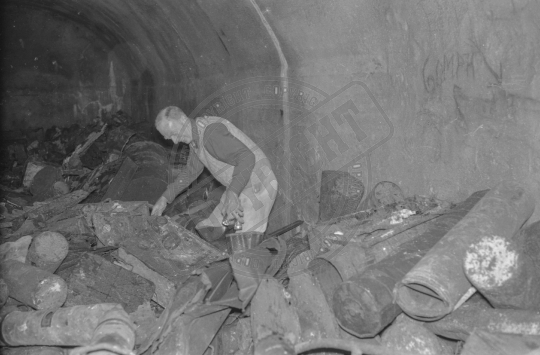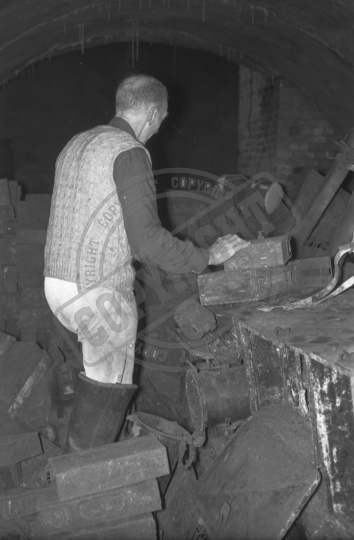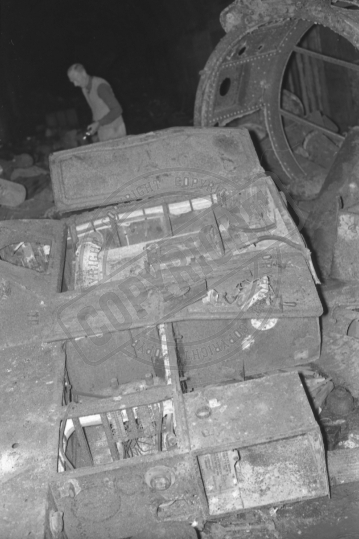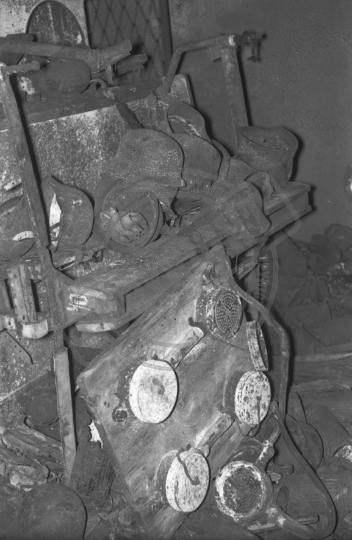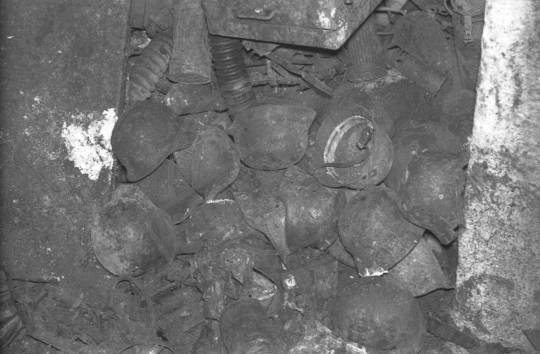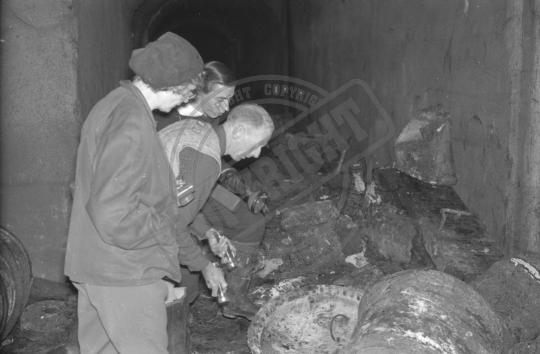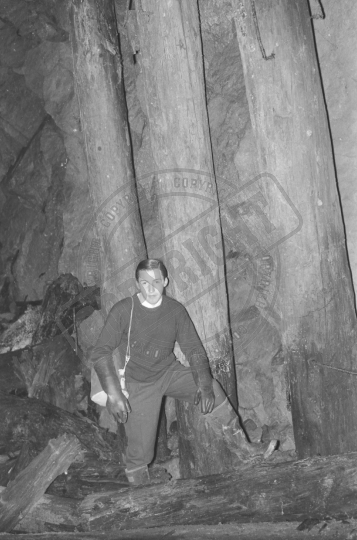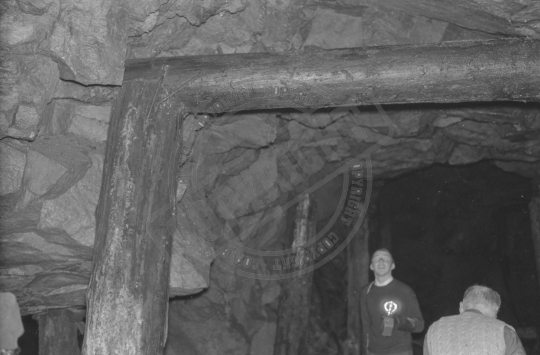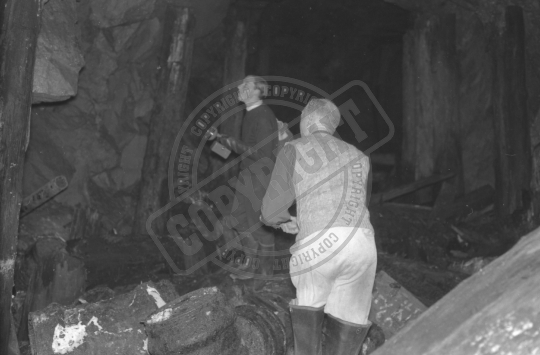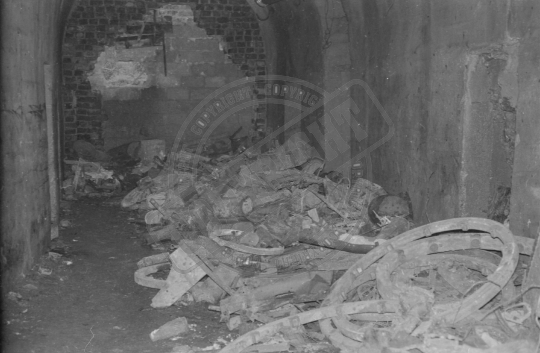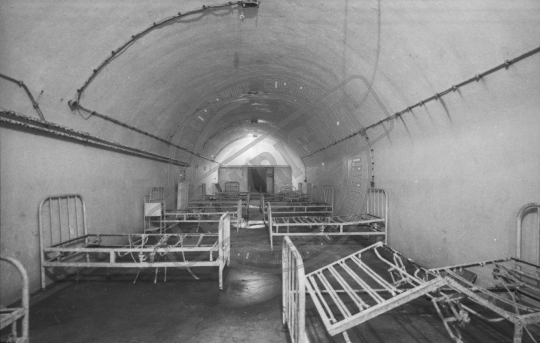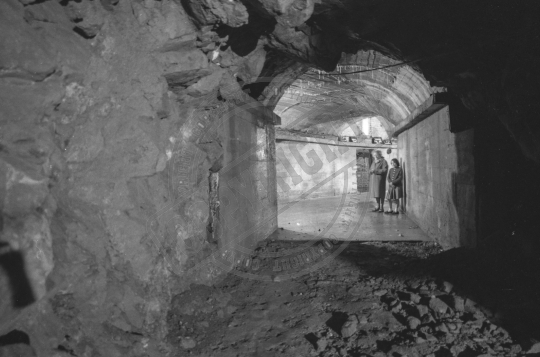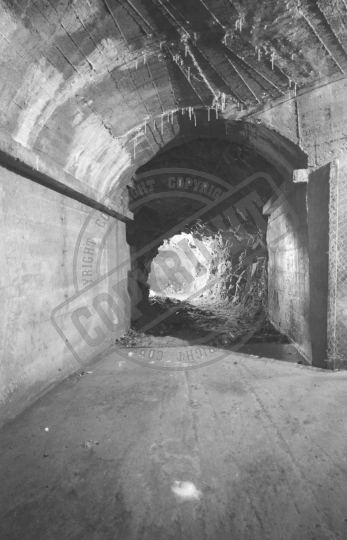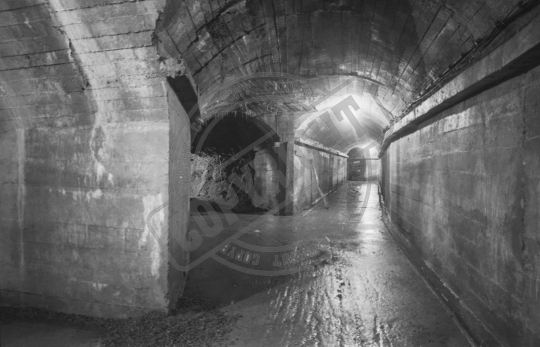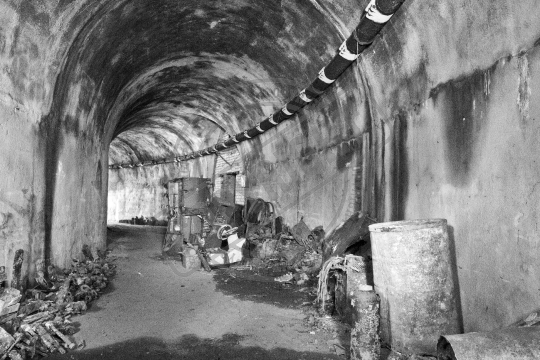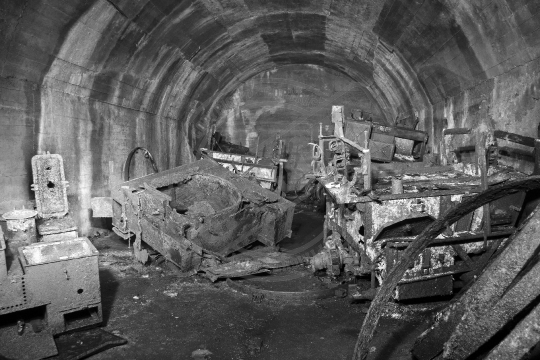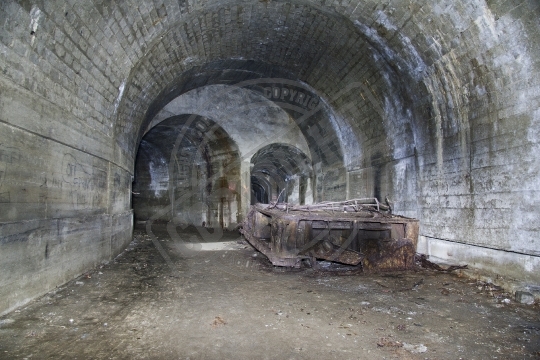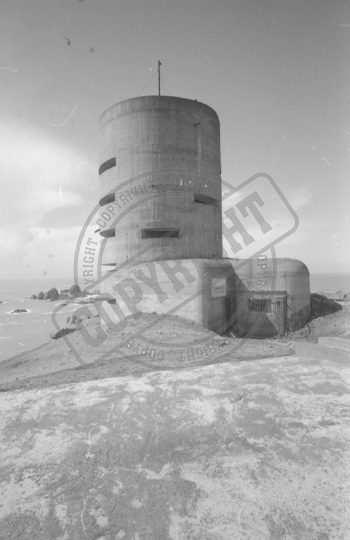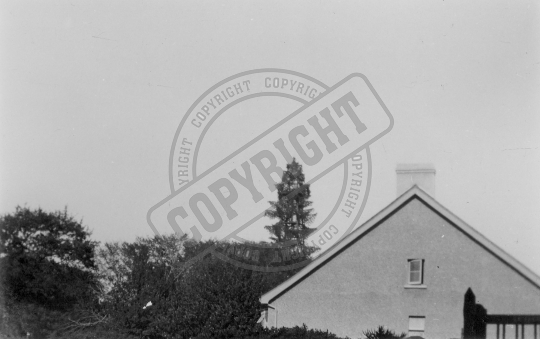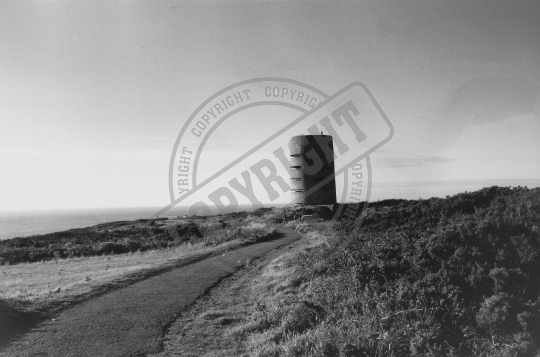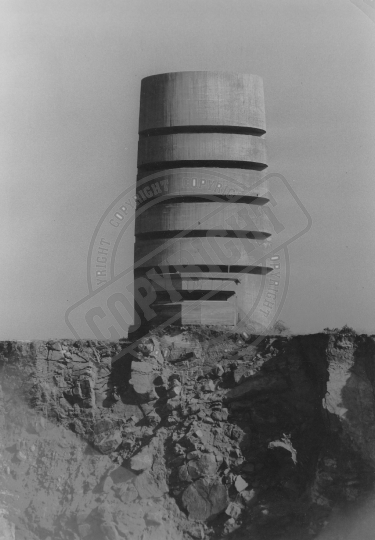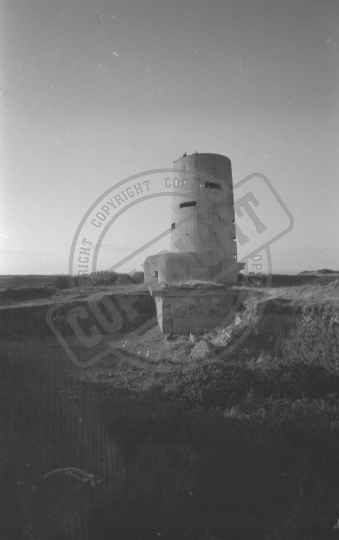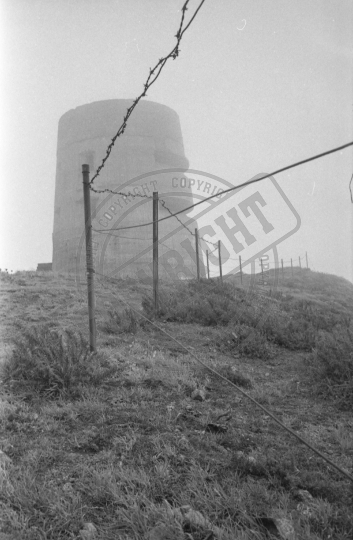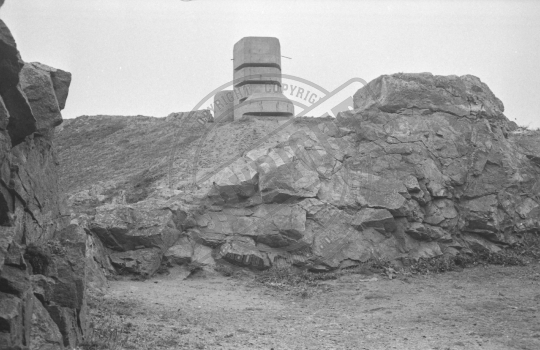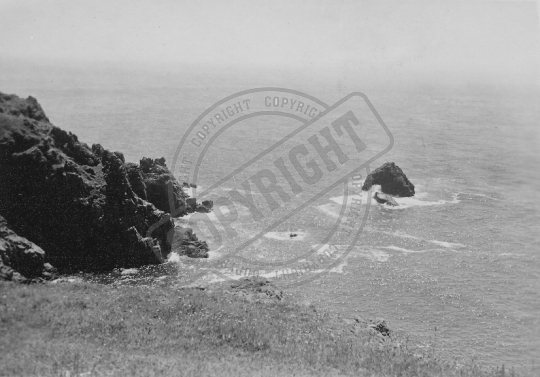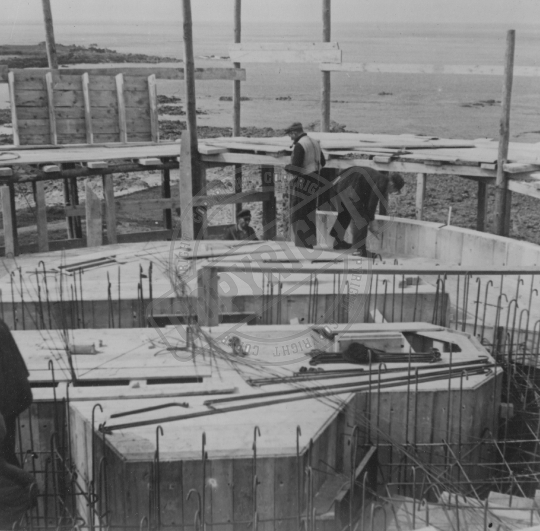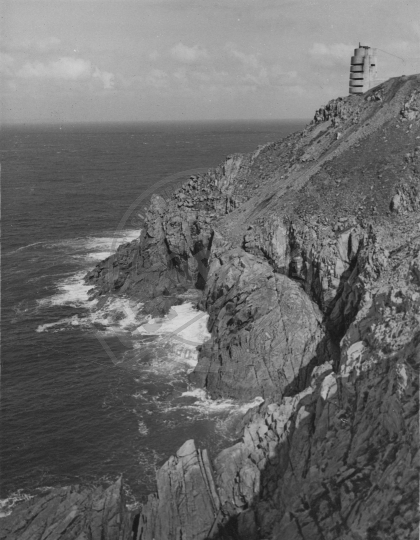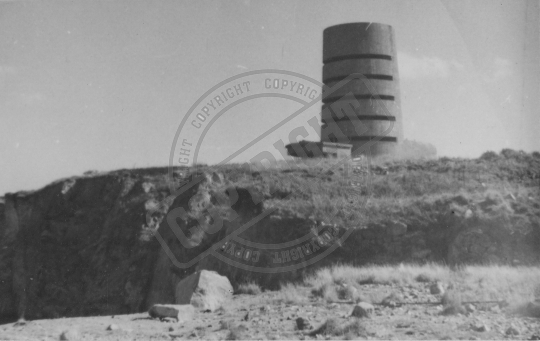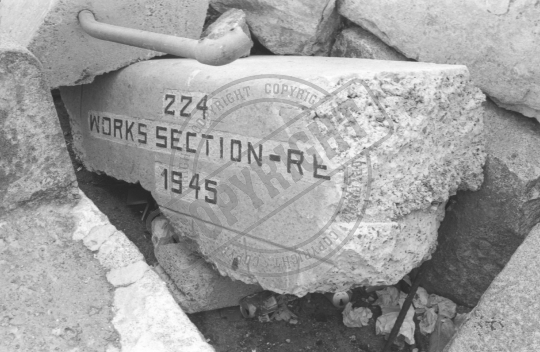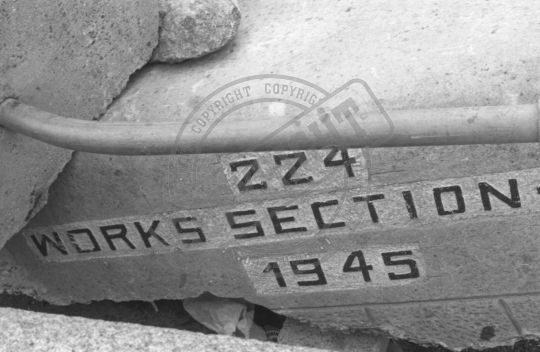Results (324)
CIMM_0031
On the afternoon of 9th May, 1945, the first detachment of troops of Task Force 135, led by Colonel Robinson, landed at the Albert Pier. After marching to the Weighbridge, they set up their headquarters at the Pomme d'Or Hotel. Upon their arrival, the Harbourmaster, Captain Richmond, hoisted the Union Flag over the balcony.
CIMM_0028
Crowds gather outside the harbour office in St Helier, Jersey on 9th May 1945 to witness a large Union Flag being draped from the first floor by Surgeon-Lieutenant McDonald with the assistance of Sub-Lieutenant David Milne.
CIMM_0026
German officers from the Kriegsmarine and Wehrmacht aboard the FK01 leave St Helier harbour to rendezvous with HMS Beagle on 9th May 1945.
CIMM_0019
Jersey, Saturday 12th May, 1945. Members of Force 135 from the initial Phases of Operation 'Moslem’ still wearing their life-vests congregate at the Weighbridge Transit Area and await orders to move to the Assembly Areas or Objectives. Behind is the Pomme d’Or Hotel that was the Tactical HQ of Force 135.
CIMM_0017
The bow doors of the beached American US LST 542 are open and the crew and British troops have commenced disembarkation. St Aubin’s Bay, Jersey on Sunday 13th May, 1945.
CIMM_0016
The bow doors of the beached American US LST 521 are open and the crew and British troops wait patiently onboard for the tide to recede sufficiently for the ramp to be lowered so that disembarkation can commence. St Aubin’s Bay, Jersey on Sunday 13th May, 1945.
CIMM_0015
The British troops received a warm welcome from the crowds lining the top of the sea wall as they disembarked from the Landing ship tank. Through the open bow doors of the HM LST 238 the troops step ashore. In the foreground a Military Policeman gives a child some friendly advice about the dangers of being on the beach as the vehicles drive off.
CIMM_0013
Surgeon-Lieutenant Ronald McDonald, RNVR, and Sub-Lieutenant David Milln, RN, shortly after landing at the end of the Albert Pier, St Helier, Harbour, Jersey, on Wednesday morning 9th May, 1945. The German sign behind them advises Achtung Nicht Ankern Hafenspere (Attention No Anchoring Harbour Boom).
CIMM_0012
The crew of HMS Beagle’s launch make ready to land, and the first Liberators stepped ashore at the end of the Albert Pier, St Helier Harbour, Jersey, on Wednesday morning, 9th May, 1945. The two officers on board were Surgeon-Lieutenant Ronald McDonald, RNVR, and Sub-Lieutenant David Milln, RN.
CIMM_0010
The crew of HMS Beagle’s launch make ready to land, and the first Liberators stepped ashore at the end of the Albert Pier, St Helier Harbour, Jersey, on Wednesday morning, 9th May, 1945. The two officers on board were Surgeon-Lieutenant Ronald McDonald, RNVR, and Sub-Lieutenant David Milln, RN.
CIMM_0009
Addresses to the crowd, from a window of the States Buildings. Many people had gathered in the Royal Square, St Helier, Jersey, for the Hoisting of the Flag Ceremony, on Thursday 10th May, 1945.
CIMM_0008
Addresses to the crowd, from a window of the States Buildings. Many people had gathered in the Royal Square, St Helier, Jersey, for the Hoisting of the Flag Ceremony, on Thursday 10th May, 1945.
CIMM_0007
Lieutenant-Colonel William Robinson, MC, RA, Island commander Jersey, addresses the crowd, from a window of the States Buildings, who had gathered in the Royal Square, St Helier, Jersey, for the Hoisting of the Flag Ceremony, on Thursday 10th May, 1945.
CIMM_0005
Lieutenant-Colonel William Robinson, MC, RA, Island commander Jersey, addresses the crowd, from a window of the States Buildings, who had gathered in the Royal Square, St Helier, Jersey, for the Hoisting of the Flag Ceremony, on Thursday 10th May, 1945.
CIMM_0003
Lieutenant-Colonel William Robinson, MC, RA, Island commander Jersey, addresses the crowd, from a window of the States Buildings, who had gathered in the Royal Square, St Helier, Jersey, for the Hoisting of the Flag Ceremony, on Thursday, 10th May, 1945.
TPL_00368
The German tunnel complex Ho.8 at La Valette was eventually cleaned out entirely in the early 1960’s prior to its conversion into an aquarium.
TPL_00352
St Saviour`s tunnel which is featured in many publications as 'The tunnel under the church’ is one of the largest German tunnel complexes in Guernsey. This tunnel was originally constructed as a ration store and in 1944 it was converted into a munitions store. On 9th May 1969 Richard Heaume and John Hayes explored the remains of the tunnel and its contents which had captured the interest of many collectors ever since the scrap men had left in the 1950’s.
TPL_00351
St Saviour`s tunnel which is featured in many publications as 'The tunnel under the church’ is one of the largest German tunnel complexes in Guernsey. This tunnel was originally constructed as a ration store and in 1944 it was converted into a munitions store. On 9th May 1969 Richard Heaume and John Hayes explored the remains of the tunnel and its contents which had captured the interest of many collectors ever since the scrap men had left in the 1950’s.
TPL_00348
St Saviour`s tunnel which is featured in many publications as 'The tunnel under the church’ is one of the largest German tunnel complexes in Guernsey. This tunnel was originally constructed as a ration store and in 1944 it was converted into a munitions store. On 9th May 1969 Richard Heaume and John Hayes explored the remains of the tunnel and its contents which had captured the interest of many collectors ever since the scrap men had left in the 1950’s.
TPL_00345
St Saviour`s tunnel which is featured in many publications as 'The tunnel under the church’ is one of the largest German tunnel complexes in Guernsey. This tunnel was originally constructed as a ration store and in 1944 it was converted into a munitions store. On 9th May 1969 Richard Heaume and John Hayes explored the remains of the tunnel and its contents which had captured the interest of many collectors ever since the scrap men had left in the 1950’s.
TPL_00343
St Saviour`s tunnel which is featured in many publications as 'The tunnel under the church’ is one of the largest German tunnel complexes in Guernsey. This tunnel was originally constructed as a ration store and in 1944 it was converted into a munitions store. On 9th May 1969 Richard Heaume and John Hayes explored the remains of the tunnel and its contents which had captured the interest of many collectors ever since the scrap men had left in the 1950’s.
TPL_00342
St Saviour`s tunnel which is featured in many publications as 'The tunnel under the church’ is one of the largest German tunnel complexes in Guernsey. This tunnel was originally constructed as a ration store and in 1944 it was converted into a munitions store. On 9th May 1969 Richard Heaume and John Hayes explored the remains of the tunnel and its contents which had captured the interest of many collectors ever since the scrap men had left in the 1950’s.
TPL_00341
St Saviour`s tunnel which is featured in many publications as 'The tunnel under the church’ is one of the largest German tunnel complexes in Guernsey. This tunnel was originally constructed as a ration store and in 1944 it was converted into a munitions store. On 9th May 1969 Richard Heaume and John Hayes explored the remains of the tunnel and its contents which had captured the interest of many collectors ever since the scrap men had left in the 1950’s.
TPL_00340
St Saviour`s tunnel which is featured in many publications as 'The tunnel under the church’ is one of the largest German tunnel complexes in Guernsey. This tunnel was originally constructed as a ration store and in 1944 it was converted into a munitions store. On 9th May 1969 Richard Heaume and John Hayes explored the remains of the tunnel and its contents which had captured the interest of many collectors ever since the scrap men had left in the 1950’s.
TPL_00339
St Saviour`s tunnel which is featured in many publications as 'The tunnel under the church’ is one of the largest German tunnel complexes in Guernsey. This tunnel was originally constructed as a ration store and in 1944 it was converted into a munitions store. On 9th May 1969 Richard Heaume and John Hayes explored the remains of the tunnel and its contents which had captured the interest of many collectors ever since the scrap men had left in the 1950’s.
TPL_00338
St Saviour`s tunnel which is featured in many publications as 'The tunnel under the church’ is one of the largest German tunnel complexes in Guernsey. This tunnel was originally constructed as a ration store and in 1944 it was converted into a munitions store. On 9th May 1969 Richard Heaume and John Hayes explored the remains of the tunnel and its contents which had captured the interest of many collectors ever since the scrap men had left in the 1950’s.
TPL_00335
St Saviour`s tunnel which is featured in many publications as 'The tunnel under the church’ is one of the largest German tunnel complexes in Guernsey. This tunnel was originally constructed as a ration store and in 1944 it was converted into a munitions store. On 9th May 1969 Richard Heaume and John Hayes explored the remains of the tunnel and its contents which had captured the interest of many collectors ever since the scrap men had left in the 1950’s.
TPL_00334
St Saviour`s tunnel which is featured in many publications as 'The tunnel under the church’ is one of the largest German tunnel complexes in Guernsey. This tunnel was originally constructed as a ration store and in 1944 it was converted into a munitions store. On 9th May 1969 Richard Heaume and John Hayes explored the remains of the tunnel and its contents which had captured the interest of many collectors ever since the scrap men had left in the 1950’s.
TPL_00333
St Saviour`s tunnel which is featured in many publications as 'The tunnel under the church’ is one of the largest German tunnel complexes in Guernsey. This tunnel was originally constructed as a ration store and in 1944 it was converted into a munitions store. On 9th May 1969 Richard Heaume and John Hayes explored the remains of the tunnel and its contents which had captured the interest of many collectors ever since the scrap men had left in the 1950’s.
TPL_00331
St Saviour`s tunnel which is featured in many publications as 'The tunnel under the church’ is one of the largest German tunnel complexes in Guernsey. This tunnel was originally constructed as a ration store and in 1944 it was converted into a munitions store. On 9th May 1969 Richard Heaume and John Hayes explored the remains of the tunnel and its contents which had captured the interest of many collectors ever since the scrap men had left in the 1950’s.
TPL_00156
Post war photograph inside the large tunnel complex known as the German Underground Hospital in St Andrews showing the layout of the wards.
TPL_00155
Post war photograph inside the large tunnel complex known as the German Underground Hospital in St Andrews. This section shows the lined to unlined junction of the tunnel.
TPL_00153
Post war photograph inside the large tunnel complex known as the German Underground Hospital in St Andrews. This section shows the lined to unlined junction of the tunnel.
TPL_00150
Post war photograph inside the large tunnel complex known as the German Underground Hospital in St Andrews.
SP_0012
During the Occupation the German forces excavated numerous tunnels in Guernsey, these were used for various purposes and many still survive today. This tunnel known as 'the tunnel under the church’ has some original equipment remaining. Note the base of the Würzburg radar on the left of the brick entrance.
SP_0010
During the Occupation the German forces excavated numerous tunnels in Guernsey, these were used for various purposes and many still survive today. Here we see a surviving concrete lined chamber within one of the larger tunnel complexes with various limbers and field kitchens still in place today.
SP_0009
During the Occupation the German forces excavated numerous tunnels in Guernsey, these were used for various purposes and many still survive today. Shown here is the southern end of the main gallery with a half track body section in the foreground. The tunnel on the left leads to the central entrance of the complex and the right to the storage area where may limbers and field kitchens survive.
TPL_00371
Post war photograph of the direction finding tower MP2 at La Corbiere, Jersey. The tower was constructed in reinforced concrete and camouflaged to look like it was constructed in stonework in an effort to resemble one of the many Napoleonic period towers that were sited around Jersey.
TPL_00142
Post war photograph of naval direction finding tower MP1 at Chouet which fell into the quarry in 1991.
TPL_00139
Post war photograph of naval direction finding tower MP1 at Chouet which fell into the quarry in 1991.
TPL_00138
Post war photograph of Army direction finding tower M5 at Le Prevote. The structure was cladded externally with granite sets during the war which has since been removed leaving the bare concrete of the structure exposed.
SP_0020
Typical of many albums, be they tourist or occupying forces, a scenic view of the cliffs and rocks of Guernsey’s south coast. Seen here is L’Angle with Tas de Pois d’Aval (Gull Rock) seen right taken c.1941, prior to the building of the tower MP4 and the German coastal artillery battery of Batterie Dollman. This Photograph is from a small collection of six taken by an unknown German soldier posted to Guernsey in 1941 with 319 Infantry Division.
OA_066
Marinepeilständen und Messtellen (Naval Coastal Artillery Direction and Range-finding Positions). Post–war view of MP 3 at Les Landes, St Ouen, Jersey, covered the sea passage between Jersey and Guernsey. This tower had Gema Seetakt radar apparatus installed that was officially named Funkmessortungsgerät West (Radio Signalling Apparatus or FuMo West).
OA_013
The German naval Tower at Chouet, Vale, designated MP 1 (Marine Peilständ und Messtellung 1). The tower fell into Mont Chouet Quarry on 22nd March, 1991. The German Army Artillery range-finding position M2 (Mebstelle 2), at the front of the tower, had fallen some years earlier in 1982.
TPL_00085
Section of concrete inscribed by the British Army with '224 Works Section RE 1945' located at St Peter Port harbour. Note RE is an abbreviation for Royal Engineers.
TPL_00084
Section of concrete inscribed by the British Army with '224 Works Section RE 1945' located at St Peter Port harbour. Note RE is an abbreviation for Royal Engineers.



